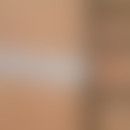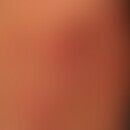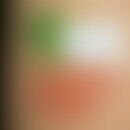DefinitionThis section has been translated automatically.
Type I allergy to the components in house dust. The most important allergens are the house dust mite (above all Dermatophagoides pteronyssinus and its main allergens Der p1, Der p2, Der p 23) and above all its excretion products, as well as feathers, animal hair and moulds. S.a. Papain.
Remark: The recently discovered allergen Der p23 belongs like Der p1 and Der p2 to the main allergens of Dermatophagoides pteronyssinus. S.a. mite allergens
DiagnosisThis section has been translated automatically.
- Medical history; prick test (sensitivity > 90% and specificity > 80% for mite asthma compared to specific bronchial provocation - see also house dust mite allergens ); provocation test (see nasal provocation test, methacholine provocation test ), intradermal test , RAST, atopy patch test .
- Determination of house dust mite exposure, detection of house dust mites or faeces using the Acarex test (1 g house dust may contain 500-10,000 mites).
You might also be interested in
TherapyThis section has been translated automatically.
- There is no causal therapy.
- The essential therapy is the reduction of the house dust mite burden, especially in areas where the patient frequently stays. Sanitation and hygiene is particularly important where mite concentrations are high (e.g. mattresses, pillows).
- Bedding accessories: Foam mattresses do not conduct moisture well. This promotes mould growth. Horsehair and kapok mattresses, sheep wool and camel hair blankets, down and feather blankets should be eliminated. Prophylactic use of mite and scaly but air-permeable covers (Allergocover from Allergopharma; Curaderm Protection from Lohmann; see below encasing).
Notice! Mattress covers should be impermeable to mites and dandruff, but permeable to air!
- Mite-killing agents: benzyl benzoate (e.g. acarosan foam, moist powder, spray solution) or disinfectants based on carboxylic acid esters. Use as foam spray for upholstered furniture and mattresses and as moist powder for large surfaces such as carpets. They are available in pharmacies. The disinfection effect is sufficient for almost 1 year. For mattresses, repeated application of Acarosan is necessary because mattresses are contaminated down to the deepest layers. It is advisable to get rid of old mattresses and disinfect new ones (see below) from the outset. Acarosan is non-irritating for skin and mucous membranes.
- Bedroom: Regular cleaning of the sleeping place (people spend about 1/3 of their life in the bedroom). Moist mopping of the floor, do not use the bedroom as a living room during the day, no combing and no personal hygiene in the bedroom (dandruff). Blankets and pillows should be washed thoroughly twice a year with water and detergent. Dry cleaning is not sufficient to remove skin scales. Airing of mattresses, all duvets, molleton sheets, pillows, sheets must be done daily, in dry weather outside. In addition, mattresses and pillows should be vacuumed daily if possible, but at least once a month. No flowers in the bedrooms. Keep doors closed as far as possible.
- Living space: Dust should not be removed with a cloth (which kicks up dust), but with a vacuum cleaner. No carpets. If carpets are present, they should be vacuumed frequently. Use vacuum cleaners with fine dust filters and allergy filters.
- It has also proved to be a good idea to install an air filter unit that removes dust from the air by ionisation using high voltages. Such devices are suitable for people allergic to pollen and are offered by companies such as Braun, Miele, Honywell, Venta.
- Bookshelves should be dusted damp, preferably glazed. Carpet beating, making beds, handling dusty cloths, brushing or sweeping as well as vacuuming must not be carried out by allergy sufferers themselves, even in their presence! Noticeable success in the renovation of the apartment can only be expected after weeks.
- For the walls, washable paint is advantageous. Venetian blinds or roller blinds instead of fabric curtains.
- Choose furniture with smooth surfaces. No ornate, dust-bearing furniture, especially no plush furniture, armchairs, blankets, mattresses, head and couch cushions. Upholstered furniture should be equipped with plastic covers and smooth covers, e.g. leather. Metal furniture made of chromium steel, plastic seats and polyethylene foam with smooth, impermeable covers are recommended.
- Lifestyle: Pets attract moisture and dirt, and repel hair, feathers and skin scales. This encourages both mite growth and mould growth. Prolonged, intimate contact with them is always accompanied by the risk of sensitisation, the development of an allergy, even to the animal hairs themselves. Bird nests, dog and cat baskets, hamster and guinea pig cages are assumed to be particularly rich in mites. Patients are not allowed to clean such storage areas themselves (the ideal solution is of course a pet-free apartment).
- Climate: Humidity favours the growth of not only dust mites but also moulds. It is important to keep the apartment dry. The purchase of a hygrometer and thermometer is useful. The room air should be kept below 60% humidity and around 16-20 °C. Underfloor heating is most suitable for heating, then central heating with radiators under the windows. Individual stoves and fireplaces are less advantageous because they create cold and therefore humid areas in the room. To maintain a constant bedroom temperature, it is useful to heat continuously during the day and at night. Air conditioners are often breeding grounds for mould. Air conditioning filters must be cleaned frequently.
- When building a house, the first thing to pay attention to is dryness. Porous, air-permeable bricks are the most favourable. Concrete never becomes completely dry. Wood absorbs moisture and should therefore be painted. Cellars are always useful. Effective drainage at the foundation wall and good insulation are recommended. In damp old buildings these measures should be carried out subsequently. Place the bedroom in a dry, well-sunlit room on higher floors, away from the kitchen and bathroom, never on the ground floor without a basement.
- For holidays, low-allergen environments such as the North Sea, desert climate, but also high mountains (Alps) have proven to be suitable.
General therapyThis section has been translated automatically.
In principle, the complete elimination of the causative allergen is the most efficient form of treatment.
Internal therapyThis section has been translated automatically.
Specific immunotherapies (SCID)now show clinically acceptable response rates and are recommended for asthmatic and rhinitic symptoms. Appropriate studies led to the approval of allergen extracts (Depigoid [containing trees/grains/grasses/herbs/mite allergen]; Depigoid-Mite Mix [containing equal parts of D. pteronyssimus and D. farinae]; Depigoid D. pteronyssinus [containing chemically modified allergen extracts from Dermatophagoides pteronyssinus]) for long-term therapy.
Alternative - SLIT tablet: In a larger multicenter, ramdomized placebo-controlled double-blind study the effect of SLIT could be proven (500IR- or 300IR/day p.o. - remark IR=Index of Reactivity). During the one-year observation period, the positive effect of hyposensitization was maintained. For the indication allergic rhinitis the preparation Acarizax® is approved, since 09.07.2021 also the preparation Orylmyte®. Allergic bronchial asthma is not a contraindication.
Note(s)This section has been translated automatically.
Dust mite allergy sufferers seem to benefit from SLIT. Retrospectively, a clinical improvement for 2-3 years after the end of SLIT could be recorded in a study with 53 test persons. An influence of SLIT on bronchial hyperreactivity or one-second exhalation capacity was not found.
Caution! Cross-reactions in clinically manifest house dust mite allergy and food allergy (see also mite crustacean mollusc syndrome) should be noted! These are based on a high homology of tropomyosin of mites, crustaceans and molluscs (see also house dust mite allergy).
A clinically relevant sensitization to house dust mites has a significantly increased risk of developing bronchial asthma compared to a pollen allergy.
LiteratureThis section has been translated automatically.
- Andersen A et al (1989) House dust mite, dermatophagoides pteronyssinus, and is allergenic. effects of washing. Allergy 44: 396-400
- Antonicelli L et al (1991) Efficacy of an air-cleaning device equipped with a high efficiency particulate air filter in house dust mite respiratory allergy. Allergy 46: 594-600
- Bergmann KC et al (2014) Efficacy and safety of sublingual tablets of house dustmite
allergen extracts in adults with allergic rhinitis. J Allergy Clin Immunol 133:1608-1614 - Bronswijk van JEMF (1978) House dust mites, occurrence and significance. Allergology 1: 55-60
- Kütting B et al (2001) The mite crustacean mollusc syndrome. dermatologist 52: 708-711
- Marogna M et al (2007) Long-lasting effects of sublingual immunotherapy for house dust mites in allergic rhinitis with bronchial hyperreactivity: A long-term (13-year) retrospective study in real life. Int Arch Allergy Immunol 142: 70-78
- Riechelmann H et al (2003) Comparison of conjunctival and nasal provocation test in allergic rhinitis to house dust mite. Int Arch Allergy Immunol 130: 51-59
- Sennekamp J et al (2002) German Society for Allergology and Clinical Immunology (DGAI) and Medical Association of German Allergologists (ÄDA) AWMF Guidelines Register No. 061/013
- Terreehorst I et al (2003) Evaluation of impermeable covers for bedding in patients with allergic rhinitis. N Engl J Med 349: 237-246
- Weghofer M et al(2013) Identification of Der p 23, a peritrophin-like protein, as a new major Dermatophagoides pteronyssinus allergen associated with the peritrophic matrix of mite fecal pellets. J Immunol 190:3059-3067
- Woodcock A (2003) Control of exposure to mite allergen and allergen-impermeable bed covers for adults with asthma. N Engl J Med 349: 225-236
Incoming links (11)
Bronchial asthma and prevention; Elisa; House dust mite; House dust mite allergy; Inhalation allergies, occupational; Methacholine provocation test; Mite crustacean mollusc syndrome; Mites; Provocation test, nasal; Slit; ... Show allOutgoing links (23)
Allergy (overview); Atopy patch test; Benzyl benzoate; Bronchial asthma (overview); Cross-reaction; Encasing; Food allergy; House dust mite; House dust mite allergens; House dust mite allergy; ... Show allDisclaimer
Please ask your physician for a reliable diagnosis. This website is only meant as a reference.




